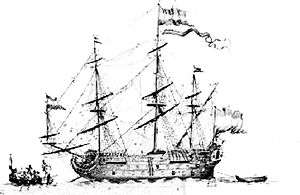HMS Coronation (1685)
Coronation was a 90-gun second-rate ship of the line of the English Royal Navy, built at Portsmouth Dockyard as part of the '30 great ships programme' of 1677, and launched in 1685.[1] She was lost in a storm off Rame Head, Cornwall on 29 October 1690 and is designated as a protected wreck under the Protection of Wrecks Act 1973. The area has been subjected to a geophysical survey and it is possible to acquire a licence and dive on the site.[2]
 Coronation | |
| History | |
|---|---|
| Name: | Coronation |
| Ordered: | 1678 |
| Builder: | Isaac Betts, Portsmouth Dockyard |
| Launched: | 23 May 1685 |
| Commissioned: | 14 February 1690 |
| Fate: | Wrecked, 3 September 1691 |
| General characteristics [1] | |
| Class and type: | 90-gun second-rate ship of the line |
| Tons burthen: | 1,345 long tons (1,366.6 t) |
| Length: | 160 ft 4 in (48.9 m) (gundeck) |
| Beam: | 44 ft 9 in (13.6 m) |
| Depth of hold: | 18 ft 2 in (5.5 m) |
| Sail plan: | Full-rigged ship |
| Armament: | 90 guns of various weights of shot |
Service
Coronation was commissioned on 14 February 1690 under Captain John Munden, as the flagship of Vice-Admiral Sir Ralph Delavall, under whom she took part in the Battle of Beachy Head, against the French, on 30 June 1690. The French won the battle and had temporary control of the English Channel.[3] Captain Charles Skelton took command of the ship on 29 October 1690.
Loss
On 3 September 1691 Coronation was patrolling the channel with the English Fleet and made for Plymouth. The exact circumstances are unclear but it is thought she dragged her anchors while trying to sit out a south-east gale in the lee of Rame Head and was driven aground in Lady Cove to the west of Penlee Point; approximately 600 men drowned, including Skelton. Only circa twenty survived.[1]
Diver trail
Part of the wreck was discovered, close to the shore in 1967 and a second offshore site was found in 1977. The area is subject to strong tidal flows, especially during spring tides. The main wreck site extends in a south-west direction, over 1300m, from the southern side of Penlee Point and artefacts are spread over a large area.[4] The site is a protected wreck, but divers can visit it under licence. Many cannon are visible.
References
Notes
- Lavery, Ships of the Line vol. 1, p. 162.
- "Information for Divers". The Coronation Wreck Project. Retrieved 15 December 2016.
- Churchill, Winston (2002). A History of the English-Speaking Peoples: Age of Revolution. London: Weidenfeld & Nicolson. p. 9. ISBN 0 304 36393 6.
- Berry, Jessica; Camidge, Kevin (2012). "Coronation Geophysical Survey". Maritime Archaeology Sea Trust. Retrieved 15 December 2016.
Bibliography
- Lavery, Brian (2003) The Ship of the Line – Volume 1: The development of the battlefleet 1650–1850. Conway Maritime Press. ISBN 0-85177-252-8.
- Winfield, Rif (2009) British Warships in the Age of Sail: 1603–1714. Seaforth Publishing.